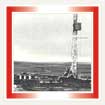|
 The
Paleozoic rock formation in the Northwest of Canada
is a thick layer of sedimentary rock, standstone,
shale and limestone. Seeping to the surface of the
Mackenzie River was oil, which was known to the
Aboriginal People living in the area. The Dene name
for the area, "Le Gohlini," means "where the oil
is." This area known now as Norman Wells is located
seventy-five kilometres south of the Arctic Circle. The
Paleozoic rock formation in the Northwest of Canada
is a thick layer of sedimentary rock, standstone,
shale and limestone. Seeping to the surface of the
Mackenzie River was oil, which was known to the
Aboriginal People living in the area. The Dene name
for the area, "Le Gohlini," means "where the oil
is." This area known now as Norman Wells is located
seventy-five kilometres south of the Arctic Circle.
 Geologist
T.O. Bosworth knew that what he saw on a trip through
the north in 1914 was promising and important. He
examined many known oil seeps and believed that they
would result in high yields of oil and gas. Even
with the call from a respected geologist, work on
the Norman Wells area did not begin until after the
First World War. In an area recommended by Bosworth
and company geologist T.A. Link, Imperial Oil began
to drill in the summer of 1920 in a seepage area
located on the Mackenzie River. In August of the
same year oil was hit at 783 feet. The flow of oil
could not be contained and burst above the derrick
floor to seventy-five metres in height. One can only imagine
the excitement that hit with such a display. Geologist
T.O. Bosworth knew that what he saw on a trip through
the north in 1914 was promising and important. He
examined many known oil seeps and believed that they
would result in high yields of oil and gas. Even
with the call from a respected geologist, work on
the Norman Wells area did not begin until after the
First World War. In an area recommended by Bosworth
and company geologist T.A. Link, Imperial Oil began
to drill in the summer of 1920 in a seepage area
located on the Mackenzie River. In August of the
same year oil was hit at 783 feet. The flow of oil
could not be contained and burst above the derrick
floor to seventy-five metres in height. One can only imagine
the excitement that hit with such a display.
 To
secure their ownership of the area, Imperial Oil
quickly staked many claims. Literally, surveyors
would place stakes in the ground at the corners of
the land claim. Development, however, was slow. A
small refinery to service local needs was built in
1933. At its maximum output in 1939, over 840
barrels were produced per day. With the advent of
the Second World War, the United States was
concerned that an attack by the Japanese would
effect oil production in Alaska. As a result, the
Norman Wells field was expanded under the CANOL
agreement. Pipelines were also built to deliver the
oil to domestic markets in Canada and the US. To
secure their ownership of the area, Imperial Oil
quickly staked many claims. Literally, surveyors
would place stakes in the ground at the corners of
the land claim. Development, however, was slow. A
small refinery to service local needs was built in
1933. At its maximum output in 1939, over 840
barrels were produced per day. With the advent of
the Second World War, the United States was
concerned that an attack by the Japanese would
effect oil production in Alaska. As a result, the
Norman Wells field was expanded under the CANOL
agreement. Pipelines were also built to deliver the
oil to domestic markets in Canada and the US.
After
the war, the pipelines were dismantled and the wells
cut off due to new finds in more accessible
southern sites, especially in Leduc. However, the
town that had grown up around Norman Wells continued
serving the mining industry.
The town is very proud of its history, and have a
site at
http://www.normanwells.com/visit/proud_history.html
 |
The men that worked in Norman Wells in the 1920s and 1930s were opening up an unknown frontier in Canada.
Listen |
 |
The sub-Arctic oil strike
On 23 August 1920, a significant petroleum discovery was made at Norman Wells, Northwest Territories by an Imperial Oil company expedition led by geologist Ted Link. In this excerpt from the JuneWarren publication, The Great Canadian Oil Patch: The Petroleum Era from Birth to Peak, author Earle Gray describes the events leading to this important sub-Arctic oil strike. Read more…
|
|
 Heritage Community Foundation Presents
Heritage Community Foundation Presents


 Heritage Community Foundation Presents
Heritage Community Foundation Presents